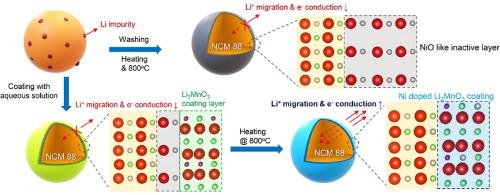Chemical Engineering Journal ( IF 13.3 ) Pub Date : 2022-01-07 , DOI: 10.1016/j.cej.2022.134577 Seonghun Jeong 1, 2 , Kwonyoung Choi 3 , Van-Chuong Ho 1 , Jiung Cho 4 , Jong-Seong Bae 5 , Sang Cheol Nam 3 , Taeeun Yim 6 , Junyoung Mun 1, 7

|
The surface instability of Ni3+ in Ni-rich layered oxide cathode materials is recognized as an obstacle in high-energy–density lithium-ion batteries. Researchers have previously attempted to solve this issue using a protective layer with a stable substance. Despite the popularity Ni-rich layered oxides, their exceptionally unstable surface has not been investigated comprehensively. Ni-rich layered oxides include lithium impurities and have a fragile surface, forming a NiO bi-phase. In this study, we perform Li2MnO3 coating to enable Ni doping via simple stirring and heat treatment combined, while considering the surface states of Ni-rich layered oxide, where lithium impurities are inevitable and a NiO bi-phase may exist. It is discovered that the tailoring interface consuming surface NiO is critical for mitigating the surface resistance. Among the samples with Li2MnO3 coating, only the sample prepared via 800 °C heating indicates the presence of Ni-doped Li2MnO3 based on electrochemical de-lithiation at 4.65 V vs. Li/Li+. It is effective in reducing NiO and stabilizing the surface for a high cycle life of 88.3% at the 100th cycle and a high rate capability of 76.9% at 5C, whereas a Li2MnO3-coated sample exhibits a cycle life of 70.4% at the 100th cycle and a rate capability of 29.1% at 5C. The surface is investigated via X-ray photoelectron spectroscopy, scanning transmission electron microscopy, and time-of-flight secondary ion mass spectroscopy analyses.
中文翻译:

Ni掺杂对锂离子电池高性能富镍层状正极界面Li2MnO3层的关键作用
Ni 3+在富Ni层状氧化物正极材料中的表面不稳定性被认为是高能量密度锂离子电池的障碍。研究人员此前曾尝试使用具有稳定物质的保护层来解决这个问题。尽管富镍层状氧化物很受欢迎,但它们异常不稳定的表面尚未得到全面研究。富镍层状氧化物包括锂杂质并具有易碎的表面,形成 NiO 双相。在本研究中,我们进行 Li 2 MnO 3涂层通过简单的搅拌和热处理相结合来实现Ni掺杂,同时考虑到富Ni层状氧化物的表面状态,其中锂杂质是不可避免的并且可能存在NiO双相。发现消耗表面NiO的剪裁界面对于减轻表面电阻至关重要。在具有 Li 2 MnO 3涂层的样品中,只有通过 800 °C 加热制备的样品表明存在基于 4.65 V 与 Li/Li +的电化学脱锂的 Ni 掺杂的 Li 2 MnO 3。它在减少 NiO 和稳定表面方面有效,在第 100 次循环时具有 88.3% 的高循环寿命,在 5C 时具有 76.9% 的高倍率性能,而 Li 2 MnO3涂层样品在第 100 次循环时的循环寿命为 70.4%,在 5C 时的倍率性能为 29.1%。通过 X 射线光电子能谱、扫描透射电子显微镜和飞行时间二次离子质谱分析来研究表面。











































 京公网安备 11010802027423号
京公网安备 11010802027423号